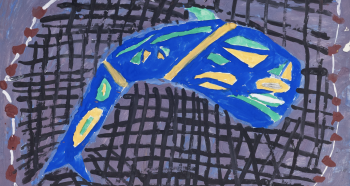Image Caption
Local Journalism Initiative Reporter
Windspeaker.com
A recent exhibit of colourful paintings was held in the British Columbia city of Port Alberni.
The exhibit, held at the Alberni Valley Museum on Sept. 28, featured paintings created by children forced to attend the Alberni Indian Residential School (AIRS) in the 1950s and ‘60s.
The show was an opportunity to learn from survivors’ experiences, and the connection between art, healing and storytelling.
When Port Alberni artist and teacher Robert Aller passed away in 2008, his family donated a collection of paintings to the University of Victoria. Aller had volunteered art classes, pushing chairs to the edges of the room and inviting children to sit on the floor with him. He taught children how to paint, not what to paint.
Dr. Andrea Walsh is an associate professor at the University of Victoria, and sits as the Smith Chair of Arts and Engagement. She was part of the team which gathered the collection.
Walsh explained Aller’s teaching style.
“He really saw art as a way out of what the kids were in,” she said. “And we see that in the paintings because he said, ‘Draw what is meaningful to you.’”
They painted masks, ceremony, and scenes of daily life – lives that were forcibly interrupted by Canada’s policies to “remove the Indian from the child.”
Memories of bright masks, ceremony, and the movement of fish in a net are powerfully descriptive of what children were missing.
Some of the works had the artists’ names. Walsh explained the team asked the university to not accept the gift, and give them the opportunity to find survivors and return their art work.
Kiikitakashuaa, Mark Atleo, a member of Ahousaht First Nation in British Columbia, received a phone call about a painting.
“I said, I never painted in my life,” he said. “Everything was blocked out.”
After a couple of calls, the team told him it has his name on the painting. “And that's when I had to go look at it,” he said.
Like many, Atleo protected the next generation from the pain.
“My children understand who I am now,” he said.
His painting was returned to him in 2013, in front of thousands of people gathered for a truth and reconciliation event. He, and some of the AIRS survivors decided the paintings should be kept by the group, to be shown at future events to raise awareness.
After 10 years of doing this work, the group formed a non-profit, composed of survivors, artists, faculty and Elders.
Chii’ Tim Sutherland, also from Ahousaht First Nation, is one of those Elders, holding cultural knowledge. He’s a singer, song leader, although he doesn’t call himself an artist. He describes receiving songs in a spiritual way, further illustrating his humility.
“What he shares comes from above,” Atleo said. “He’s a very special person who has all that knowledge – gifts that tell our stories in his songs. And that's the real art.”
Ⱡax, Fran Tait, who is from Lax Kw’alaams Band in B.C., also went to AIRS. She said that for a long time being at residential school “was not a topic that people talked about.”
She was the first Indigenous academic advisor at Malaspina College in B.C.
“It was only later when I started talking to high school students, college university students or RCMP, that I was then able to talk – because I was on my healing journey as well,” she said.
“I would talk to these groups and right between the eyes, there was nothing I would leave out because I think it's important that you speak your truth and not sugar coat it.”
The work of returning art grew into an educational program, powerfully expanding the archive of records of the Truth and Reconciliation Committee of Canada. The story of the paintings’ return forms part of the TRC’s Executive Summary Report (page 334 and 335).
Atleo said it's important for the children to learn at a young age, and from Indigenous teachers.
“All they get now is all European teachers,” he said. “There's very little history on our own people and that needs to get out more. And they're starting to realize how much knowledge we had. And still have.”
Walsh said the Canadian Museum of History is working on a national curriculum, which includes 136 paintings and videos of the survivors’ narratives.
The AIRS Repatriation website said its purpose will be “to educate visitors about reconciliation, challenging the way in which Canadians see themselves.”
View the AIRS Repatritation website here

